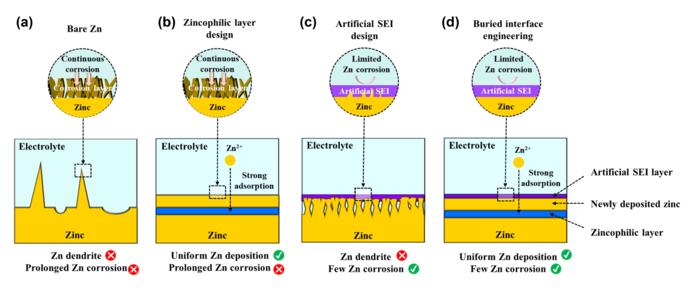
The development and application of aqueous zinc-ion batteries have been significantly hampered by two critical issues: dendrite growth and corrosion. Dendrites can compromise battery performance by forming irregular structures during the charging process, inevitably leading to short circuits and ultimately, catastrophic failures. At the same time, corrosion plays a destructive role by degrading the metal anode over time, adversely affecting the longevity and reliability of batteries. These compounding problems pose serious challenges for researchers and manufacturers alike, stifling the potential of aqueous zinc-ion systems in real-world applications.
In a groundbreaking study, researchers from the School of Metallurgy and Environment at Central South University have unveiled an innovative strategy to mitigate the detrimental effects of both dendrite formation and corrosion on zinc anodes. Their approach centers around an advanced concept known as buried interface engineering, which provides a unique solution to these pervasive issues and paves the way for more robust energy storage systems. The researchers collaborated closely with industry experts to develop a layered structure that optimally combines zincophilic and corrosion-resistant materials.
The core of this strategy involves the incorporation of a zincophilic tin (Sn) layer situated within a protective zinc sulfide (ZnS) outer layer. The ZnS layer is crucial, acting as a barrier to protect the newly deposited zinc from the corrosive effects of the electrolyte. Meanwhile, the Sn layer adopts a unique role by possessing an inherent affinity for zinc atoms, which facilitates their nucleation and subsequent smooth deposition. This dual-layer structure aims to enhance the overall stability and efficiency of zinc anodes under operational conditions, representing a significant leap over conventional zinc anodes.
Extensive experimental testing has validated the efficacy of the proposed SZS coating, demonstrating several advantages over traditional bare zinc systems. During symmetric cell testing, the SZS-coated zinc anode operated remarkably well, showcasing stable cycling performance that exceeded 280 hours at a current density of 10 mA cm-2 and an areal capacity of 10 mAh cm-2. This remarkable result starkly contrasts with that of bare zinc, which could only endure for approximately 41 hours under identical conditions.
Moreover, the performance of full cells such as SZS@Zn//MnO2 has shown remarkable long-term cycling stability. The SZS@Zn configuration achieved a cycling stability of 63.6% after 1000 cycles at a high discharge rate of 10C, a significant enhancement compared to bare zinc’s 47.2% stability. These results provide compelling evidence that buried interface engineering can substantially improve the performance and durability of zinc-ion batteries.
The researchers performed meticulous observations and analyses of the morphology and composition of the anode both before cycling experiments and after extended use. The findings revealed that the SZS-coated zinc anode exhibited a uniform deposition of zinc and suffered considerably less corrosion compared to its bare counterpart. These observations underline the effectiveness of the innovative coating in fostering a more conducive environment for zinc deposition and reducing the adverse impacts of corrosion.
Additionally, the approach taken by the research team illuminates possibilities for further advancements in energy storage technology. By offering valuable insights into the rational design of stable interfaces for metal anodes, the buried interface engineering strategy opens new avenues for developing more efficient, reliable, and long-lasting batteries. This innovation not only addresses the immediate issues of dendrite growth and corrosion but also contributes to the broader challenge of improving battery technologies for diverse applications.
The ramifications of this research extend beyond mere laboratory results. The findings hold great significance for the future of energy storage solutions and could potentially affect various sectors, including renewable energy, electric vehicles, and portable electronic devices. With sustainability and efficiency being paramount concerns in today’s rapidly advancing technological landscape, such advancements are critical for the future success of energy storage systems.
Funding and support from several prominent agencies, including the National Natural Science Foundation of China and local innovation programs, were instrumental in bringing this project to fruition. Such collaborations underscore the integral role of academic and governmental support in driving forward critical research initiatives aimed at addressing global energy challenges.
Given the extensive nature of this study and the promising outcomes, further research and development initiatives are warranted to fully understand and exploit the capabilities of buried interface engineering in aqueous zinc-ion batteries. The research team is optimistic about the potential of their findings to usher in a new era for energy storage technologies.
In conclusion, the research conducted by the team from Central South University marks a significant advancement in the quest to overcome the challenges associated with aqueous zinc-ion batteries. By implementing an innovative buried interface engineering strategy, they have offered a solution that not only enhances the performance and durability of zinc anodes but also provides valuable insights for future technological developments in this critical field of study.
Subject of Research: Buried interface engineering for zinc anodes in aqueous zinc-ion batteries
Article Title: Novel Buried Interface Engineering Mitigates Dendrite Growth and Corrosion in Zinc Anodes
News Publication Date: [Insert Publication Date]
Web References: [Insert Web References]
References: [Insert References]
Image Credits: Credit: ©Science China Press
Keywords
Dendrite growth, corrosion, zinc-ion batteries, buried interface engineering, energy storage, zincophilic layer, zinc sulfide layer, battery performance, cycling stability, research collaboration
Tags: advanced battery engineering solutionsaqueous zinc-ion battery challengesbattery reliability and longevityburied interface engineeringcorrosion resistance in batteriesdendrite growth preventionenergy storage system improvementsinnovative battery materialslayered battery structure designzinc anode stabilization techniqueszinc-ion battery performancezincophilic materials in batteries





